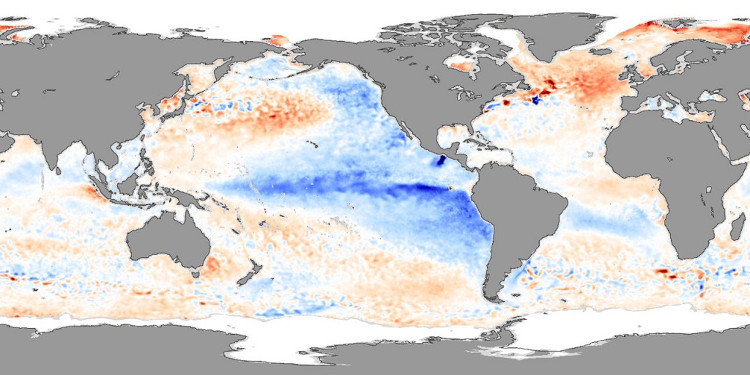What is La Nina phenomenon?
La Nina is a phenomenon of cold sea water compared to normal, this is a phenomenon contrary to the phenomenon of El Nino (sea water warming). La Nina phenomenon usually begins to form from March to June every year, and has the strongest influence at the end of the year until February next year. La Niña will happen immediately after the El Nino phenomenon ends. La Nina phenomenon of cold sea currents cools the temperature of the areas through which it passes.
Learn about La Nina phenomenon
In Spanish, La Niña also means "little girl" to denote the opposite of the El Nino phenomenon. La Nina is also known as El Viejo or Anti-El Nino . The temperature of the ocean water in the Pacific region is unusually cold along with other neighborhoods, the temperature is also unusually reduced. La Nina phenomenon may appear as soon as El Nino phenomenon weakens, but sometimes it is not so.

Pacific surface temperature in November 2007.
La Nina phenomenon will cause storms on the Atlantic Ocean but reduce the risk of storms in the Pacific. In the US, winter temperatures are warmer than normal in the Southeast and colder in the Northwest. The temperature dropped significantly, so it will cause a severe cold to the affected area.
Studying the phenomenon of El Nino and La Nina to understand the physical mechanism, characteristics and rules of evolution as well as the consequences of their impacts, we can warn the appearance of El Nino and La Nina, the possible effects on weather, climate and socio-economy to take measures to prevent and effectively avoid and mitigate losses caused by El Nino and La Nina.
Characteristics
The phenomenon of El Nino and La Nina shows anomalous fluctuations in the atmosphere - ocean system with a time scale between years, cyclical or standard cycle.
The operation cycle of the El Nino phenomenon ranges from 2 to 7 years, sometimes over 10 years. The average time of an El Nino phenomenon is 11 months, the longest of 18 months (El Nino 1982 - 1983).
The cycle of La Nina phenomenon usually lasts longer than the cycle of El Nino phenomenon. The average time of one occurrence of La Nina phenomenon is 14 months, at most 24 months.
- 'The phenomenon of La Nina will end globally
- La Nina phenomenon continues to last until early 2008
- La Nina weather phenomenon has reached its peak
- WMO: La Nina's weather phenomenon is about to end
- La Nina is coming back
- La Nina may be the cause of a pandemic
- El Nino goes, La Nina comes
- Vietnam may suffer from heavy rain
- El Nino is about to end in the Caribbean
- NASA: We are experiencing the peak of El Nino
- The North is about to enter the peak of the winter cold
- La Nina arrived early
 Is the magnetic North Pole shift dangerous to humanity?
Is the magnetic North Pole shift dangerous to humanity? Washington legalizes the recycling of human bodies into fertilizer
Washington legalizes the recycling of human bodies into fertilizer Lightning stone - the mysterious guest
Lightning stone - the mysterious guest Stunned by the mysterious sunset, strange appearance
Stunned by the mysterious sunset, strange appearance